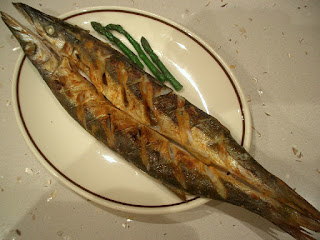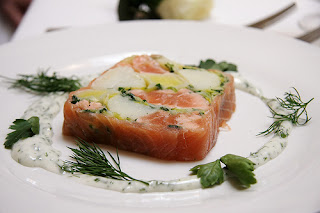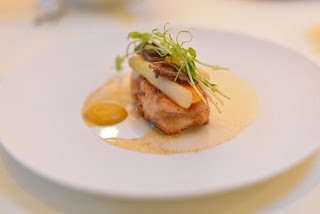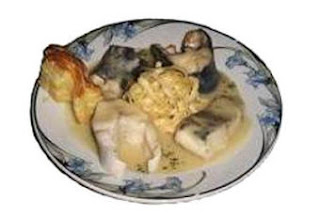from
Behind the French Menu
by
Bryan G. Newman
behindthefrenchmenu@gmail.com

Lingue, Élingue, Julienne.
Ling, European ling, Mediterranean ling.
Photograph
courtesy of La Paysanne Des Mers
I had enjoyed Ling, the fish, in France when it
used to be on the menu as lingue. However, twenty years ago, in a restaurant in
Beaucaire, in south-eastern France.
I learned that what we call a ling by any other name would taste as sweet as Julienne. Marketing had upgraded the fish’s name and the menu offered a Filet of Julienne. At the time, I only knew of Julienne as a distinct cut used for vegetables, though my online French-English dictionary offered Julienne as a “long fish,” but that is not a very helpful description for a diner.
Fortunately, I was in a restaurant where the Maitre D’ knew his fish, and while he did not use the name Lingue, he told me that it was an excellent fish from the cod family. There are many different fish from the cod family, and I have enjoyed quite a few of them under a variety of names, so I ordered the Filet of Julienne. The dish was well prepared, and the fish was excellent, and as expected, it had a similar taste and texture to cod. N.B. Cod is neck to neck with salmon as the most popular fish in France.
(Beaucaire in the department of Gard in the region of Occitanie is 25 km (16 miles) from the beautiful city of Avignon).

Face to face with a Ling.
Photograph
courtesy of Ed Bierman
www.flickr.com/photos/edbierman/2585185143/
Ling, have long, tubular, bodies which, at first sight when pulled from the sea, may be thought of as a conger eel. These fish often reach close to one meter (3.3’) in length though you will rarely see a whole ling on sale at a fishmonger’s. Most ling are caught in the frozen north and reach the French markets as chilled filets. Since ling are members of the cod family, their meat is white, firm, and slightly flaky and easily mistaken for cod when served with a sauce.
N.B. The name Julienne for this fish is confusing as one of the traditional cuts of French vegetables has long been called a Julienne. All French chefs must learn many cuts of vegetables before they graduate and a Julienne de Légumes will be long, thin cuts of vegetables, about 5cm by 2mm x 2mm (2” x .08” x .08”).

Julienne de Concombre
A julienne of cucumbers
Photograph
courtesy of Stacy Spensley
www.flickr.com/photos/notahipster/4670390442/
The word Julienne or Lingue on French menus covers two very close members of the Ling fish family. There is no practical way to tell the difference when these two fish are cooked, so no harm is done. However, a third member of the Ling family is also seen on French menus called the Blue Ling, Lingue Espagnole. It is a smaller fish with a slightly different texture and taste, and is not included in this post.
Julienne and Lingue on French Menus:
Dos de Julienne au Cote du Jura – A thick cut from the back of the fish, the meatiest portion, served with a sauce made from a white wine from the department of Jura in the region of the Bourgogne-Franche-Comté. that borders Switzerland. This dish will have been prepared with a white wine though the Côtes du Jura AOP wines include reds, rosés, whites, vin jaune, and their unique Cotes du Jura Corail, a coral-colored wine.
N.B. The Vin Jaune AOP, Vin de Paille AOP, and their
excellent and inexpensive sparkling Crémant
du Jura are also part of the Côtes du Jura AOP appellation.
Catch your own Ling.www.flickr.com/photos/kencurtis/4939447570/
Filet de Julienne à la Nantaise – A filet of ling served with one of France’s favorite sauces for fish, Sauce Nantaise. Sauce Nantaise is also called Sauce Beurre Nantaise and under the name Sauce Beurre Blanc it is one of the most popular sauces to be served with fish. Sauce Nantaise is named after the lovely City of Nantes in north-western France, in the Pays de la Loire region. Nantes itself is set on the River Loire close to the Atlantic Ocean. This menu listing was my introduction to ling under its now more popular French name Julienne.
The English language website of the Nantes Tourist Information Office is:
http://en.nantes-tourisme.com/touristic-information-3114.html

The City of Nantes.
Photograph
courtesy of Pierre Guezingar
www.flickr.com/photos/popierre/21725955268
Filets de Lingue aux Brocolis et aux Amandes – Filets of ling prepared with broccoli and almonds.
Médaillon de Lingue Poché et sa Crème aux Poireaux – A ling filet poached in a cream of leek sauce. The word médaillon, a medallion in English, indicates a round or oval cut; however, with fish a médaillon, is used as an alternative name for a filet.
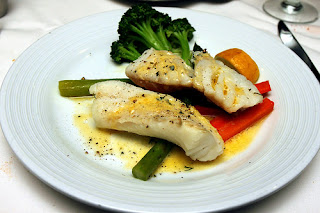
Grilled Ling.
Photograph
courtesy of Prayitno
www.flickr.com/photos/prayitnophotography/15873332281/
Pavé de Julienne à la Crème d'Amande et Féve Tonka - A thick cut of ling served with a cream of almond sauce flavored with the tonka bean. The tonka or tonquin bean is a plant from South American with a strong vanilla aroma. If you sniff a little more, you will also find the scent of cherries and cinnamon. In France, the tonka bean is mostly used in aniseed-flavored alcoholic drinks. N.B. The tonka bean is not a real bean; it is from the pea family. In the USA and some other countries, the sale of the tonka bean is controlled as one of its ingredients is considered poisonous when consumed in quantity..
For more about the tonka bean, see Gernot Katzer's Spice Pages:
http://gernot-katzers-spice-pages.com/engl/index.html
Soupe de Poisson Maison (Julienne, Moules, Langoustine) – The restaurant’s special fish soup made with ling, mussels and Dublin Bay prawns.

Ling Sushi
Photograph
courtesy of John.
www.flickr.com/photos/johnjoh/5000993394
Suprême de Julienne Sauce Champagne – A filet of ling served in a champagne sauce. The cut called suprême will usually be on menus listings for a breast of chicken, pigeon, Guinea fowl, and other birds. Nevertheless, when a chef gets bored using the word filet for fish, then suprême may appear on the menu.
The town of Beaucaire
Beaucaire has a written history from the Roman times, through to its place as an important medieval market town and on to its place in history when Captain Napoleon Bonaparte added to Beaucaire's fame by writing his first, or at least his first pro-revolutionary pamphlet in 1793. The year 1783 was the first year of the civil war, and Napoleon was at that time only an Artillery Captain. Then he wrote Le Souper de Beaucaire, Supper in Beaucaire. In the pamphlet, a soldier is speaking with four royalist merchants in an attempt to bring them around to the benefits of the revolution.
Beaucaire appears in French literature as it is mentioned in the Count of Monte Christo, by Alexandre Dumas (père) and Les Miserables by Victor Hugo amongst mentions in many other novels.
Relaxing in Beaucaire
A maitre d'hôtel from Paris told me that at least once a year he comes to Beaucaire to fish for carpe, carp, and the silure, the Wells catfish. on the river and canals. According to him, carp catches of seven or eight kilos are claimed every day and 15 kilos or more when no one else is around! The other reason he chooses to come here is just as important, fishing makes you hungry and thirsty, and he loves the local wines, their Vin de Pays, now vins IGP, and the local cheeses and sausages.
Salade Beaucaire made with celery, York ham, mushrooms, and beetroots in a sauce vinaigrette may be on the menu all over Provence though it is in Occitanie. Beaucaire's restaurants are influenced mainly by Provence, and your choice of local wines will include the pleasant Vins du Pays du Gard IGP and the Vins de Pays d'Oc IGP.
Despite the peace and quiet that fishing may provide, not everyone wants to spend a week fishing in Beaucaire. For the restless, it is only 15 km (10 miles) to the towns of Arles and Nîmes and 25 km (16 miles) away is Avignon. You may also do as we did and rent a self-drive motorboat with bedrooms, bathrooms, kitchen, and air-conditioning to use on the Beaucaire canal and more. We traveled to the beautiful old garrison town of Aigues Mortes in the Camargue on the Mediterranean coast. When we rented one of these boats, we were very short on time with only a weekend to spare, and it was a fantastic way to see this part of France. With more time available, we would have continued to the beautiful Mediterranean fishing port of Sète. For those, who have an additional ten or fourteen days for traveling, consider continuing from Sète along the Canal du Midi, the Canal des Deux Mers all the way to Bordeaux on the Atlantic coast.
The Beaucaire canal was built in the 17th century and became part of the Canal du Rhône à Sète. When it was finished, produce from Avignon, Arles, Nimes, and the area around could be transported in quantity and quickly to the Mediterranean and onwards to the Atlantic and Paris.
Course Camarguaise
For summer entertainment, Beaucaire has Course Camarguaise
acrobatic exhibitions, mostly with cows, not bulls. Here, the cows are neither
mistreated nor killed; they are working professionals. In the Course
Camarguaise, the cows have a rosette tied between the horns, and the aim is to
grab it and win a prize.

A
Course Camarguaise acrobatic display with cows,
not
a bullfight.
Photograph courtesy of jmt-29
www.flickr.com/photos/jmt-29/7409532374/
The players here are accomplished acrobats dressed all in white; at the end of the show, they let the public join in to try and grab the rosette from a calf. Do not join in lightly; these calves are old hands at the game, and they know a greenhorn when they see one.
https://www.provence-camargue-tourisme.com/?lang=Anglais

A
Beaucaire parking lot.
Photograph courtesy of GK Sens-Yonne.
www.flickr.com/photos/sens-yonne/15718143065/
Arles is Close to Beaucaire
The day after enjoying the Julienne in a Beaucaire restaurant, I took the opportunity to visit the primary fresh produce market in Arles. The city of Arles is the gateway to the Camargue, and it is a 25-minute drive from Beaucaire. Arles is also famous for the pictures of sunflowers that Vincent van Gogh painted there. Unfortunately, none of Van Gogh’s original paintings remain in Arles. Here, Van Gogh invited Paul Gauguin as a guest to his home and would later cut off his ear, making Gauguin take him to a hospital and then to a lunatic asylum. You may visit the home of Van Gogh in Arles and view the hospital where he was taken.
The Arles Produce Market
In the Arles market, among some other food research I was engaged in, I asked a wholesale fishmonger about the fish called Julienne. Fortuitously, I had found a knowledgeable fishmonger who put up with my problematic French. He confirmed that Julienne is the fish called Lingue in commercial French, with Julienne now used as a more marketable name. Then, pointing to boxes just received marked with chilled, but not frozen, filets of Ling that he gets every two days from his wholesaler. From the dates on the box, I could see the fish were packed in Norway and had taken four days from ship to shop. The fishmonger added that he occasionally receives whole fresh Ling from the Mediterranean, but his restaurant and fishmonger customers prefer the chilled variety that comes already skinned and deboned.
Roman Arles.
Apart from fish, Van Gogh, and Paul Gaugin, Arles has the best-preserved Roman amphitheater in Europe. The Arles English Language Tourist Information Office website is:
https://www.arlestourisme.com/en/

The Roman amphitheater of Arles.
Photograph courtesy of Phillip
Capper
www.flickr.com/photos/flissphil/2960427559/
A fish from North America called Ling
There is
a fish called Ling or Red Hake caught off the East coast of the United States;
however, this is a much smaller fish and from a different family to the Ling
seen in Europe and the Mediterranean.



